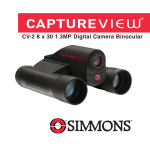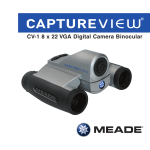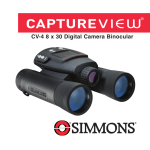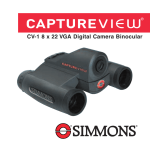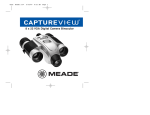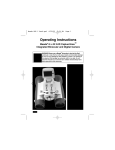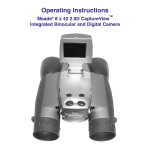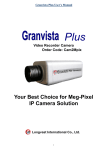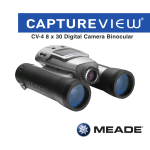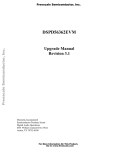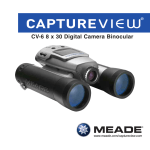Download Meade CaptureView 8x30 Specifications
Transcript
® CV-2 8 x 30 1.3MP Digital Camera Binocular Contents Quick Start ................................................................................ 4 Features .................................................................................... 7 Introduction .............................................................................. 9 How to Use Your Binocular ......................................................10 Adjust Eye Relief, Barrels......................................................10 Focus the Binocular ..............................................................11 How to Use Your Camera..........................................................12 Insert Batteries, Select an Operation ....................................12 Select Near or Far Focus ......................................................13 Taking Pictures and Video ........................................................14 Take a Still Picture ................................................................14 Capture Video........................................................................15 Capture Video Using Flashback ............................................16 Some Suggestions for Using Flashback ..............................17 Operations ................................................................................18 Use the Mode and Shutter Button ........................................18 Use the Camera Mode, Change the Camera Resolution......19 Use the Video Mode, Use Flashback ....................................20 Erase (Delete) Pictures or Video ..........................................21 Find Out How Many Pictures You’ve Taken ..........................21 Use the Self-Timer, Format and Load Memory Card ............22 Find Out Why CaptureView is Beeping ................................23 Turn Buzzer On or Off ..........................................................23 Find Out How Much Power is Left in the Battery ..................23 Download Pictures ................................................................24 Install Image Editing Software ..............................................26 Other Software and System Requirements ..............................27 Maintenance and Troubleshooting ............................................28 Specifications............................................................................29 3 Quick Start How to start taking pictures... 1 Install 2 AAA batteries (not included). 2 Turn on camera. Press and hold down Mode for 3 seconds. 3 Point at something interesting. 4 4 Press the Shutter. You’ve taken a picture! Quick Start How to use Flashback... Have you ever wanted to record just the play of the game (for example, your son or daughter kicking the winning goal)? Flashback icon Use Flashback when you want to capture video of a short activity—without using up all your memory. You’ll begin recording, but with Flashback selected, you’ll only save the last 10 seconds of video. Note: You must have a user-supplied SD card for Flashback to operate. To insert the SD card, press the card into the SD card slot with the pin side up and release when you hear a click. 5 6 7 8 Turn on camera. Press and hold down the Mode button for 3 seconds. Mode Button Shutter Button Select the Flashback Mode. Press the Mode button until the Flashback icon displays. Point at an interesting activity and press the Shutter button to enter the record mode. Press the Shutter button again to stop recording. CaptureView has recorded only the last 10 seconds of the activity. See FLASHBACK, and SUGGESTED USES FOR FLASHBACK, pages 16 and 17 for more information. 5 Quick Start How to download your pictures... USB Cable 9 Plug in. Connect CaptureView to your PC or Mac (OS 9.0 or higher) using the included USB cable. Sit back and relax a minute. If using Windows 98ME or higher, CaptureView automatically installs on your PC. No drivers are needed. If using Windows 98SE or lower, drivers must be installed on your PC and can be found on the included CD-Rom. 10 1 Install Ulead Photo Express. Insert the CD, click on Ulead Photo Express and follow the on-screen instructions. 12 6 Enjoy your photos. Open Ulead Photo Express to view, edit and print your pictures. Features e f f b c d Fig. 1: Top View 1. Mode Button 2. Shutter Button 3. Diopter Scale (right eyepiece) 4. LCD Panel 5. Barrels Fig. 1 7 Features Fig. 2 h j i g 1) g 1$ 1# Fig. 3 8 1! 1@ 1! j Fig. 2: Rear View 6. Eyepieces 7. USB Port 8. SD Card Port 9. Rubber eyecups 10. Focus knob Fig. 3: Front View 11. Objective Lens 12. Battery Compartment Lid (push forward and lift to remove) 13. Camera Lens 14. Focus Ring Introduction Congratulations on purchasing the Meade® CaptureView® CV-2. CV-2 is an 8 x 30mm full-featured binocular. It is integrated with a digital camera that requires no film to capture pictures or video. This manual is designed to quickly guide you through the operation of your CaptureView CV-2. For best results, take a few moments to become familiar with the operation of your device, and save this manual for future reference. CaptureView has the following features: • Fully functional binocular. • Digital camera that captures pictures and video. • Flashback feature allows you to easily record just the highlight of an activity. • LCD display panel indicates status for ease in performing desired operations. Important Note: Images stored in the camera’s internal memory will be lost if the batteries are depleted or if the batteries are removed. Therefore, download pictures before you remove the batteries. However, images stored on user-supplied SD cards (commonly known as “flash memory cards”) will not be lost if the batteries are depleted or removed. If it is critical that you save a set of pictures, it is recommended that you use an SD card. To conserve battery life, remove batteries after downloading images to a computer. There is continual battery drainage even when CaptureView is turned off. Be sure CaptureView is off before changing batteries. WARNING! Never use a Meade binocular to look at the Sun! Looking at or near the Sun will cause instant and irreversible damage to your eye. Eye damage is often painless, so there is no warning to the observer that damage has occurred until it is too late. Do not point the binocular at or near the Sun. Children should always have adult supervision while observing. 9 How to Use Your Binocular If you want to... Do this... Adjust Eye Relief If you wear eyeglasses, fold down the rubber eyecups and hold the eyepieces up against your glasses. Fold down Adjust the Barrels You need to adjust the barrels, as the distance between your eyes is usually different than the distance between another person’s eyes. Barrel 10 Barrel 1. Hold CaptureView up to your eyes in the normal viewing position. Use both hands to hold each barrel firmly. 2. Pull the barrels apart or push the barrels together until you see a single circular field with both of your eyes. How to Use Your Binocular If you want to... Focus the Binocular Diopter scale Focus knob Do this... 1. Set the Diopter Scale on underside of CaptureView at its center point between “+” and “-.” 2. Choose an object (such as a telephone pole) that is at least 50 feet (15m.) away. 3. Looking with only your left eye, rotate the Focus Knob until the object you are viewing is focused. 4. Looking with only your right eye, rotate the Diopter Scale until the object you are viewing is focused. 5. Now, looking with both eyes, rotate the Focus Knob to focus on both far and near objects. 11 How to Use Your Camera CaptureView performs best under good lighting conditions. Take some time to practice capturing still pictures and video. Depending on the available light and your distance from the object, captured images may not appear as bright or centered as viewed through the binoculars. CaptureView takes focused pictures even if the image in the binoculars is out-of-focus. If you want to... Insert Batteries Battery compartment Select an Operation Mode 12 Shutter Do this... 1. Make sure camera is off before changing batteries. 2. Push the battery compartment lid forward and lift to open. 3. Insert 2 AAA 1.5v (user-supplied) batteries into the compartment, noting the correct polarity as illustrated inside the compartment. • Press and hold the Mode button for 3 to 5 seconds to turn on the camera. • Press the Mode button to display and cycle through the operation icons on the LCD. • Press the Shutter button when the desired icon is displayed to select an operation. Near and Far Focus If you want to... Select Near or Far Focus Focus Ring Note: The Binocular focus knob does not affect the camera focus. The camera’s focus is determined by the Focus ring setting: Near Focus: Use for objects that are 30 to 60 feet away. Near focus will capture crisp, sharp images of nearby objects, especially people. Far Focus: Use for objects more than 60 feet away. Do this... 1. Press and hold the Mode button for 3 seconds to turn on the camera. 2. The binocular can be focused using the focus knob. However, the camera can be set to Near or Far focus using the focus ring, and is not affected by the focus knob. 3. To set the Near focus: Position CaptureView so that you are looking at the front lens and focus ring. Rotate the focus ring to the “man” icon. You will feel a click. Continue to rotate slightly past this point. If you are unable to rotate the ring to the left, the camera may already be set to Near focus. To set the Far focus: Position the binoculars so that you are looking at the front lens and focus ring. Rotate the focus ring to the “mountain” icon. You will feel a click. Continue to rotate slightly past this point. If you are unable to rotate the ring to the right, the camera may already be set to Far focus. 13 Taking Pictures and Video If you want to... Take a Still Picture Mode Shutter The amount of pictures you can take: High Resolution (1280 x 1024): 12 Low Resolution (640 x 480): 40 The number of photos you may take will decrease if you have also taken video. 14 Do this... 1. Press and hold the Mode button for 3 seconds to turn on the camera. The camera will beep and the camera icon displays on the LCD. The counter, battery life and resolution icons also display. 2. Point the binoculars at an object. You may use the focus knob to focus the image in the binocular, but keep in mind that you may choose Near or Far focus for the camera. In other words, the camera’s focus is not affected by the binocular’s focus knob. 3. Hold CaptureView steady and press the Shutter button. Note that the counter advances. For example, if the counter reads “0016,” this means that this is your sixteenth picture. Taking Pictures and Video If you want to... Capture Video Mode Shutter The maximum length of a movie: 30 seconds. Do this... 1. Press and hold the Mode button for 3 to 5 seconds to turn on the camera. 2. Press the Mode button once and the Video mode icon displays. 5. Point the binoculars at the scene you wish to capture. 4. Press the Shutter button. The camera now captures video. 5 The counter keeps counting (in seconds) as you capture video. Press the Shutter button again to stop recording video. Note that the counter stops and the number of pictures advances by one (a video segment counts as one object). The length of video will decrease if you have also taken still pictures. You may take longer movies using a user-supplied SD memory card. 15 Flashback If you want to... Capture Video Using Flashback This feature is very useful when you wish to capture a short activity, but are not sure when it will begin. This feature captures video for 10 seconds. Select the Flashback menu icon and then press the Shutter button to activate recording. Note: You must have a (user-supplied) SD card to use the Flashback feature. 16 Do this... For example, you may want to record a baseball pitcher throwing a pitch: 1. Select the Flashback icon. 2. Press the Shutter button to begin recording while the pitcher prepares. After the pitcher throws the ball, click on the Shutter button again to turn off recording. You’ll have saved only the last ten seconds of the pitcher’s activity. Flashback Some suggestions for using Flashback Let’s say your daughter is on the varsity basketball team. And right now, she’s dribbling down the court. You’d like to capture her patented hook shot on video. This is a job for Flashback. Select the Flashback icon and press the Shutter button as she sets off down court. The ball is passed back and forth, and is kicked out of bounds. But don’t touch the Shutter button just yet to stop the recording. Keep following the action. An opponent puts the ball back into play, your daughter steals the pass.....she sets....she shoots.....skyhook....she scores! Now press the Shutter button to stop the recording. The last ten seconds has been saved to video. Everything else— all the unimportant activity—is discarded. Using this method, you can record 7 or 8 of the best plays of the game. Or let’s say your last name begins with “J” and your son is graduating from college. The Dean begins calling the “J’s.” Select the Flashback icon and press the Shutter button to start recording. Finally the big moment arrives, it’s your young man’s moment in the sun. After he accepts his diploma and high fives the Dean, press the Shutter button again and you’ll have this unforgettable memory saved to video. 17 Operations If you want to... Do this... Use the Mode and Shutter Buttons Mode Shutter Note: If you do not perform an operation for 60 seconds, the camera automatically switches off. Operation Icons Camera Self-Timer Video Resolution Flashback Erase All Erase Last Format Storage Beeper 18 • Press and hold the Mode button for 3 to 5 seconds to turn the camera on or off. • Use the Mode button to cycle through the operation icons. As you press the Mode button, the operation icons display on-screen in the following order: Camera Video Flashback (when SD card present) Self-timer Quality/Resolution Erase Last Image Erase All Images Format Storage Beeper On/Off The next press returns you to the Camera icon. • Press the Shutter button when the desired icon is displayed to select an operation. • Use the Shutter button to take a picture, and to begin or end the recording of a movie. Operations If you want to... Use the Camera Mode Do this... • Keep pressing the Mode button until the Camera icon displays. Then press the Shutter button to take a still picture. Camera Icon Change the Camera Resolution High and Low Resolution Icons H: High Resolution mode (1280 x 1024). L: Low Resolution mode (640 x 480). The default setting is High Resolution. • Select a Resolution setting before taking a still image: 1. The first time you turn on the camera, it displays the High Resolution icon (“H”). This is the default setting. 2. To change the resolution, keep pressing the Mode button until the Low Resolution icon displays (“L”). Then press the Shutter button to activate Low Resolution. Low resolution allows you to capture more images with your camera. 19 Operations If you want to... Use the Video Mode Video Icon Do this... • Keep pressing the Mode button until the Video icon displays. Then press the Shutter button to begin recording a movie. Press the Shutter button again to stop recording. Note: The length of a movie depends on how much memory you have available. Audio recording is not available with this camera. Use Flashback Flashback Icon Note: Flashback captures 10 seconds of video. 20 • Keep pressing the Mode button until the Flashback icon displays. Then press the Shutter button to begin recording a movie. Press the Shutter button again to stop recording. See pages 16 and 17 for more information. Operations If you want to... Erase (delete) Pictures or Video Erase Last Icon Erase All Icon Find Out How Many Pictures You Have Taken Do this... • Erase Last. Keep pressing the Mode button until the Erase Last Image icon displays and then press the Shutter button. The icon flashes. Press the Shutter button again to erase the last captured image or movie. • Erase All. Keep pressing the Mode button until the Erase All Image icon displays and then press the Shutter button. The icon flashes. Press the Shutter button again to erase all the images and video. Check out the LCD Counter. The counter displays the number of pictures or videos taken. Counter Display 21 Operations If you want to... Use the Self-timer Self-Timer Icon Format your SD Card Note: The first time you use the SD card, you need to format it. Format Storage Icon Card Present Icon Load or Eject Memory Card Note: If you wish to copy files from your flash card, make sure you change the Read-Write setting on the card to "Write." See your flash card’s instructions for more information. 22 Do this... • Keep pressing the Mode button until the Self-timer icon displays and press the Shutter button. The camera then pauses for about 10 seconds: It sends out 6 slow and then 6 fast warning beeps before taking the picture. • Load the SD card and choose this icon. When the icon begins to flash, press Shutter to begin formatting. Note: The Card Present icon displays when an SD card is in the camera. • Press the card in and release when you hear a click. Operations If you want to... Find Out Why CaptureView is Beeping Note: When the battery is low, CaptureView sends out six short high beeps. It is recommended you download the pictures or change the batteries at this time. You have 60 seconds to change the batteries before your images are deleted. Do this... Listen for the following patterns: Power on: Two short high beeps. Wake up: One long high beep. Sleep: One short high beep. Takes a picture: One short high beep. Failed to take picture due to insufficient memory: Three short high beeps. Low battery: Six short high beeps (beeps only when power is On). Self-timer: Sends out 6 slow, then 6 fast beeps before taking a picture. Turn the Buzzer On or Off • Keep pressing the Mode button until either the Buzzer On or Buzzer Off displays and then press the Shutter button. Find Out How Much Power is Left in the Batteries • Check the battery indicators on the display. Battery Indicators 23 Operations If you want to... Download Pictures Do this... If using Windows 98SE or lower, drivers must be installed on your PC and can be found on the included CD-Rom. If using Windows 98ME or higher, CaptureView automatically installs on your PC. No drivers are needed. USB Port Note: You cannot load to a Unix system using the camera's USB port— this port can download only to Windows OS or Mac OS 9.0 or higher. However, by using a flash card reader, you can also download your images to a Macintosh using an OS earlier than 9.0 or to a Unix system. When using a flash card reader, the flash card looks like a hard drive to your computer. 24 Just attach one end of the USB cable to the camera's USB port and the other end to your PC's USB port. Your PC considers the camera as a mass storage device and displays it like a hard drive. You can then copy your still pictures or video to your computer or even copy files to the memory on the camera. Operations If you want to... Download Pictures (continued) Note: See “Troubleshooting,” page 28, for more information about connecting CaptureView to your PC. Note: If you are using a Mac OS 9.0 or higher, drag the memory card icon to the trash before disconnecting the USB cable. Do this... 1. Using the provided USB cable, plug the one end of the cable into the camera's USB port and the other end into your PC's USB port. 2. If using Windows 98SE or lower, drivers must be installed on your PC. See the included CD-Rom. If using Windows 98ME or higher, CaptureView automatically installs on your PC. No drivers are needed. 3. After setup is complete, using Windows Explorer, you can browse the camera's memory as if it were a hard drive. 4. If CaptureView does not appear in Windows Explorer, it might be using a drive letter that has already been assigned by your PC (e.g., C:, D:, E:, etc.). Use Windows' Disk Manager program to change the drive letter to an unassigned letter (e.g., K:). 5 You may now copy images or files from the camera's memory to your PC just as you would with any external hard drive or flash memory. 25 Operations If you want to... Install Image Editing Software (Ulead Photo Express) Note: If you are connected to the internet and you click on the Meade logo on the splash screen, you will go to meade.com. 26 Do this... 1. Insert supplied CD Rom into your PC’s drive. 2. A splash screen displays. Click on “Ulead Photo Express.” 3. Follow on-screen instructions. 4. After you click “Finish,” the Ulead Photo Express icon appears on your desktop. 5. Double-click the icon to launch the program. You can now view, edit and print your images. Photo Express allows you to browse the camera's memory as if it were a hard drive. Operations Other Software The included CD ROM contains other software programs by Ulead that will assist you in editing your images, allow you to transfer images to email, and provide you with other useful functions. Ulead Photo Express®, Photo Explorer, and Cool 360®, and CaptureView Manager are proprietary programs, and may not be sold, licensed or distributed without the express written consent of Ulead. For more information about Ulead Photo Express, visit the Ulead website at www.ulead.com/pe. Click on the "Product Documents" link in the Download section of their homepage to find a link for the Photo Express manual. Ulead®, Cool 360® and Photo Express® are trademarks or registered trademarks of Ulead Systems, Inc. in the United Staes and/or other countries. System Requirements • Windows 98SE/Win Me/Win 2000/Win XP Note: If using Windows 98ME or higher, CaptureView automatically installs on your PC. No drivers are needed. If using Windows 98SE or lower, drivers must be installed on your PC and can be found on the included CD-Rom. • 200MHz (or equivalent) processor or faster. • 64MB of RAM free over System requirements • Video (VGA) card with 2MB of RAM for minimum 16-bit (High Color) display. • 4x CD-ROM drive. • USB port (1.1). • 600MB of free hard drive space. If you have questions regarding your PC system specifications, please contact your PC manufacturer. For the latest firmware updates and technical assistance, go to: www.meade.com/captureview 27 Maintenance Care of your CaptureView 1. Never immerse CaptureView in liquid. Remove dust or stains with a soft cloth dampened with water or neutral detergent. Keep in a dry, cool dust-free environment or a container when it is not being used. Do not spray liquid cleaners directly onto LCD. Using only gentle pressure, wipe the LCD with a slightly dampened cleaning cloth. 2. Important Note: Images stored in the camera’s internal memory will be lost if the batteries are depleted or if the batteries are removed. Therefore, download pictures before you remove the batteries. However, images stored on user-supplied SD cards (commonly known as “flash memory cards”) will not be lost if the batteries are depleted or removed. If it is critical that you save a set of pictures, it is recommended that you use an SD card. To conserve battery life, remove batteries after downloading images to a computer. There is continual battery drainage even when CaptureView is turned off. Be sure CaptureView is off before changing batteries. 3. Avoid dropping CaptureView. Do not disassemble CaptureView. Troubleshooting It is very important to use the following connection and disconnection procedures to download pictures. 1. Only connect CaptureView to your PC when the PC is on and Windows has completed loading. 2. Avoid physically connecting, disconnecting and reconnecting the camera during a download session. Instead, disconnect the camera using Windows software: Rightclick the USB on-screen icon and select disconnect (or connect to reconnect). 28 Specifications Binocular power Binocular objective lens diameter Binocular optical design Binocular close focus Field of view (diagonal) Binocular field of view Image capture resolution Maximum length of movie Camera aperture 8X 30mm Folding roof prism, fully-coated 16 ft. 7.9° 366 ft. at 1000 yds. 1280 x 1024, 640 x 480, 24-bit color Up to 30 seconds f/4.0; fixed lens Camera optimum range Near Focus: 30 ft. to 66 ft. Far Focus: 66 ft. to infinity Memory Storage capacity at each resolution 16MB SDRAM 640 x 480: 40 images 1280 x 1024: 12 images Windows 98SE/2000/Me/XP 41° to 104° F (5° to 40° C). 20%-85% relative humidity, non-condensing USB Icon LCD 4.25" W x 2.4" H x 5.75" D Two x AAA 1.5V alkaline USB cable, instructions, neck strap, cleaning cloth, carry case, CD ROM with image editing software Operating system requirements Operating environment Interface type Display Product dimensions Batteries (user supplied) Accessories (included) 29 BINOCULAR/DIGITAL CAMERA LIMITED WARRANTY Every Meade binocular/digital camera is warranted by Meade Instruments Corporation (“Meade”) to be free of defects in materials and workmanship for a period of ONE YEAR from the date of original purchase in the U.S.A. and Canada. At its option, Meade will repair or replace the product, or part thereof, found upon inspection by Meade to be defective, provided the defective part or product is returned to Meade, freight prepaid, with proof of purchase. This warranty applies to the original purchaser only and is non-transferable. Meade products purchased outside North America are not included in this warranty, but are covered under separate warranties issued by Meade International Distributors. RGA Number Required: Prior to the return of any product or part, a Return Goods Authorization (RGA) number must be obtained from Meade by writing, or by calling Meade Customer Service at (800) 62-MEADE. Each returned part or product must include a written statement detailing the nature of the claimed defect, as well as the owner’s name, address, and phone number. This warranty is not valid in cases where the product has been abused or mishandled, where unauthorized repairs have been attempted or performed, or where depreciation of the product is due to normal wear-and tear. Meade specifically disclaims special, indirect, or consequential damages or lost profit, which may result from a breach of this warranty. Any implied warranties which cannot be disclaimed are hereby limited to a term of one year from the date of original retail purchase. This warranty gives you specific rights. You may have other rights which vary from state to state. Meade reserves the right to change product specifications or to discontinue productions without prior notice. This warranty supersedes all previous Meade binocular warranties. ANY RETURN MADE IN THE U.S.A. UNDER THIS LIMITED WARRANTY MUST FOLLOW THIS PROCEDURE: 1. Carefully package your binocular/digital camera to avoid shipping damage; use a thick-walled carton box for mailing. 2. Enclose a written statement detailing the exact nature of the service needed. Be sure to include the RGA number, your name, address, plus daytime and evening telephone numbers. 3. Enclose $10.00 to cover handling and return-shipping, by check or money order payable to “Meade Instruments.” Non-warranty repairs may entail additional charges which will be confirmed with you before any binocular/digital camera repairs are initiated. 4. Insure the package and send your binocular/digital camera, freight prepaid, to: Meade Instruments Corporation, Attn: Binocular/Digital Camera Repair 6001 Oak Canyon, Irvine, California 92618 ® The names “CaptureView” and “Meade,” and the Meade logo, are trademarks registered with the U.S. Patent Office and in principal countries throughout the world. All rights reserved. © 2004 Meade Instruments Corporation. 30 ADVANCED PRODUCTS DIVISION Meade Instruments Corporation World’s Leading Manufacturer of Telescopes for the Serious Amateur 6001 Oak Canyon, Irvine, California 92618 J www.meade.com © 2004 J (949) 451-1450 82-242-01010 v1.0 08/04A
































